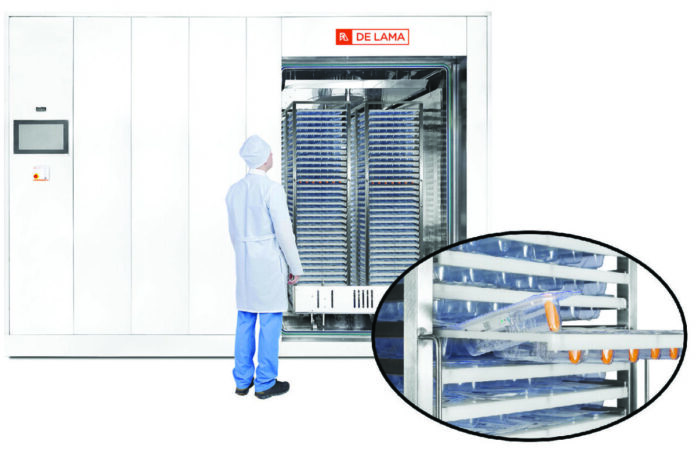<p style=”text-align: right;”><span class=”td_text_highlight_marker_red td_text_highlight_marker”>COMPANY NEWS</span></p>
For many years there has been talk of a criticality of the sterilization process with EtO, and the national, European and American regulatory bodies have progressively made the regulations more stinging. The FDA, for example, has repeatedly raised awareness on the issue and launched competitions to promote alternative technologies. The pandemic has temporarily put this controversy on hold, but today the issue appears far from resolved.
Providing its own solution, De Lama has developed its HyPure® technology that leverages hydrogen peroxide, but paired it with a unique process and equipment to enable it to be used for a wider range of products.
As Guido Rovera, marketing and sales director, and Marco Bianchi, marketing and sales of De Lama spa explain, this low temperature sterilization process can be used for numerous medical devices that previously cannot be treated with hydrogen peroxide, but allows numerous decidedly innovative applications also in the pharmaceutical industry.
What impulse prompted De Lama to create the new HyPerPure® technology?
Bianchi: We can say that De Lama, as a manufacturer of EtO (Ethylene Oxide) sterilizers for over 50 years, has directly perceived both the requests from customers and authorities, primarily FDA, to arrive at an alternative technology to EtO.
EtO is an extremely critical agent: it is toxic, carcinogenic and flammable, characteristics that make it difficult and expensive to manage, also by virtue of increasingly restrictive international regulations.
In this context, De Lama accepted the challenge of developing an alternative sterilization method. HyPerPure® represents the success of these efforts.
How does this technology work?
B. One of the reasons we registered the HyPerPure® brand was to clearly distinguish it from traditional peroxide technologies. The first note that was initially made to us by customers was that “the peroxide technology already existed but was not effective“.
Traditionally, this technology is associated with surface sterilization, now used in decontamination units, or pass-boxes, also produced by De Lama. Vaporized peroxide is also used, for example, for the decontamination of the inside of insulators.
With traditional technology, however, the fluid is vaporized and determines its action only on the exposed surface of the product. With a simple vaporization it is not possible to penetrate into complex product geometries or Tyvek® packaging, where medical devices, syringes and prostheses are normally placed.
HyPerPure® technology differs in that it works in deep vacuum and airless conditions. With this method, hydrogen peroxide is able to reach all internal surfaces, just like it happens with EtO autoclaves. For example, it can penetrate and sterilize the internal part of long and extremely thin catheters, which is absolutely impossible with traditional techniques, and it can penetrate Tyvek® packaging ensuring complete sterilization (12 logs) of all the products contained within them.
In a sense, we reproduce what happens with traditional saturated steam sterilization, where the air in the chamber is totally replaced by steam in a saturated state. In addition, the De Lama generator performs the ionization of vaporized H202, improving the effectiveness of sterilization.
What is the difference with H202 plasma sterilization?
Rovera: Sterilization with H202 plasma is a technology widely used in hospitals but cannot be used for production purposes, since it allows the use of chambers with a maximum size of 500 liters. This limit is dictated by the use of an electric field to break up the H202 molecules.
De Lama’s technology, on the other hand, has no size limits and allows plants to be built over 50 cubic meters. Furthermore, the “plasma” devices use proprietary cartridges with a very high cost, while HyPerPure® uses the “classic” peroxide at a concentration of 35% for commercial use, easily available on the market. Finally, plasma sterilizers do not allow to process products packaged inside Tyvek® or medical paper, because they are unable to penetrate the membrane as is the case with HyPerPure® implants.
Does the new technology involve risks for the environment?
A: Our technology works only with hydrogen peroxide which at the end of the cycle is destroyed by a catalyst, which splits H202 into hydrogen and oxygen molecules, which can be released safely into the atmosphere.
H202 is not explosive and it is therefore very simple and not at all critical to store it in plastic cans without particular safety measures. The doors of the De Lama plants can be opened at the end of the cycle when the concentration of 1 ppm is reached, as required by law.
The total environmental compatibility of this technology creates a revolutionary advantage for many manufacturers consisting in the fact that the equipment can be installed directly inside production plants, even located in areas with a high population.
What other advantages does HyPerPure® offer over EtO?
B. The speed: the HyPerPure® sterilization process has an average duration of 3-5 hours against 8-12 hours for EtO. In addition, the ETO requires additional pre- and post-conditioning processes that bring the overall duration to 24-48 hours. A huge difference compared to the 3-5 hours of our technology.
There is also a significant saving in space (and capital expenditure) since all the auxiliary equipment necessary for the ETO such as burners, pre- and post-conditioning rooms, storage for refilling cylinders, etc. disappear. The fact that the equipment can be installed directly inside a production plant allows further savings in time and costs, since external sterilization is no longer necessary.
In practice, one minute after production and packaging, the product can be sterilized and, therefore, the product is immediately deliverable to the customer. This means that the company also has greater control over the entire development process and the bottlenecks created in external sterilization centers are no longer imaginable.
What are the advantages from a cost point of view?
A. There are many economic advantages but one point I want to emphasize is the low cost of the sterilizing agent. Since the consumption of the H202 cycle is very low, the cost of the media compared to the EtO for a single cycle is also lower by about 80%. In addition, the equipment does not require any consumables: the catalyst is static and there are no filters to replace, also reducing maintenance costs. A detail that is by no means negligible is that the systems are not pressurized bodies and therefore do not require PED certification for their use. Finally, as regards the HVAC systems of a structure, there is no impact and the equipment can be added to a pre-existing system without a specific preliminary study of the air flows.
What are the fields of application of this technology?
B. Let’s start by saying that the technology stands out for being “at low temperature”, therefore absolutely ideal for heat-sensitive products, but nothing excludes using it also for non-heat-sensitive products traditionally sterilized with other techniques, such as saturated steam. It is therefore an extremely flexible and versatile technology.
The main application domain is represented by the medical device and prosthesis industry, due to the thermal sensitivity of most of the products: catheters, intracardiac catheters, syringes, cochlear implants, implant prostheses, etc. can be sterilized.
Another domain is that of the pharmaceutical industry.
An example is the sterilization of the inside of the packaging of pre-filled syringes in aseptic. In a nutshell, class A packaging of syringes inside blister packs is avoided, with a huge saving of expensive class A space. Packaging takes place first, in a declassified area (for example in a class C) and subsequently the packaging containing the pre-filled syringe can be inserted into the autoclave with HyPerPure® technology which determines the passage of the H202 through the Tyvek® and the sterilization of the inside of the packaging, of the air and of the external surface of the syringes. In this case, therefore, it is not a question of sterilizing the liquid inside the syringes as the filling has already occurred in asepsis. This process has particular value when the liquid inside the syringes cannot withstand certain temperatures and therefore a terminal sterilization of the packaging with saturated steam or air / steam mixture is not conceivable.
Another application linked to the pharmaceutical industry, destined to become more and more successful, is the coupling of a De Lama plant to an isolator through a direct connection made thanks to Magnetodoor®, our patented magnetic drive door. In this way, HyPerPure® can sterilize both the products introduced into the insulator and, and this is revolutionary, the pieces of the filling line under the insulator, in particular those in heat-sensitive plastic materials. Since this type of system can combine multiple technologies, one can also imagine washing and then sterilizing the pieces of the filling line with the HyPerPure® process, within the same chamber, without ever opening the insulator. This is an approach that, in line with the new Annex 1, revolutionizes the workflow by eliminating any risk of cross-contamination at the root.
On your site you state that this is the “greenest” sterilization technology in the world.
B. Yes, we started working on this technology to overcome the criticalities of the ETO but we have come to create the most ecological sterilization technology on the market. In addition to what has already been said, it is worth underlining that our process, even compared to other sterilizers such as saturated steam autoclaves, involves almost zero water waste and very low energy consumption, also thanks to the fact that, working at low temperatures , does not require the abatement of high temperatures. In this way we arrive at the definition of “The greenest sterilizer on the market”, an element that we consider extremely relevant these days.
Are there any other elements you want to share with readers?
A. Yes, we want to emphasize the fact that HyPerPure® is not a prototype or a technology under development, it is currently available implants, already in operation at major international companies in the pharmaceutical, medical device and orthopedics sectors. The process, which represents the future of low temperature sterilization, is validated and supported by current regulations.
Presenting ecological advantages and related to the reduction of production times and costs, HyPerPure® is a must for manufacturers of orthopedic devices and medical devices, but also in the Pharma. Furthermore, the De Lama laboratories are always open to carry out tests on specific customer products.
Related page:


